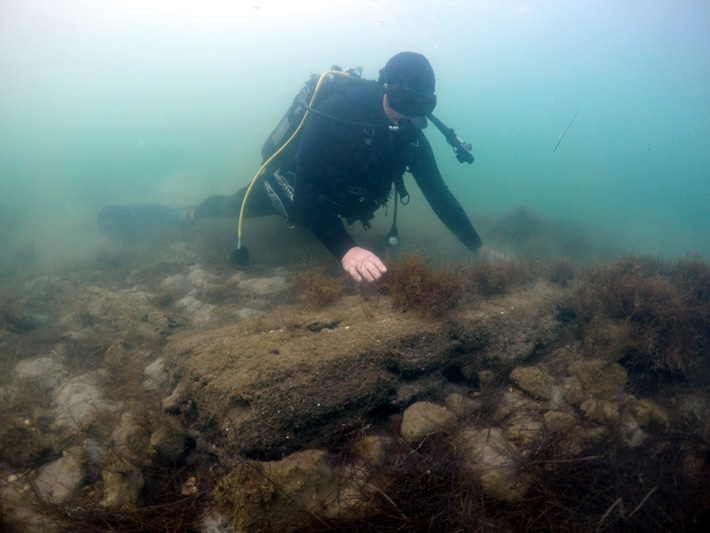3,500-Year-Old Sunken Town Discovered In Croatia
Mato Ilkić and Mate Parica from the Department of Archeology at the University of Zadar recently discovered a much older port in the western part of the Novigrad Sea, 22 kilometers northeast of Zadar.
Zadarski List writes that numerous ports from the Roman Empire have long been located and partly explored on the northern Dalmatian Coast.
They are distributed along the main maritime route of the time, which, among other things, includes navigation on the Vir Sea, Zadar, and Pašman Channels. But Mato Ilkić and Mate Parica from the Department of Archeology at the University of Zadar recently discovered a much older port.

It is located on a hitherto unknown route that was very navigable in the period before the Roman conquests.
The archeological remains of this port lay in the western part of the Novigrad Sea, opposite Posedarje, 22 kilometers northeast of Zadar. It was built by the Liburnians, and, for now, it is their only port for which the exact location is known.
“Examining aerial photographs, we noticed that along the west coast of the Novigrad Sea not far from Posedarje, and directly next to the huge prehistoric hillfort Budim, there are some dark rectilinear outlines.
We went there to dive and on the seabed, we immediately spotted a structure pointing to an ancient harbor whose archaeological remains are approximately 3 meters deep. For now, it is the oldest port in Liburnia, and perhaps in the entire Croatian part of the Adriatic.
This is evidenced by the radiocarbon analysis of wood from the port structure, a sample of which we sent to Miami for testing. We recently got a result from Florida that made us quite happy, because it indicates an older time than we had assumed. Namely, the so-called C 14 date indicates that the port was built between 371 and 199 BC. Thus, it belongs to the period of the late classical phase and early Hellenism,” Ilkić reveals.
The port is quite large and is not layered with later interventions. It is built partly of large stone blocks and wooden beams. This very demanding and complex construction undertaking at the time could only be carried out by the well-organized and economically very powerful Liburnian community, which was obviously oriented towards maritime and trade, directly or indirectly with very remote overseas regions.
This included North Africa, that is, Carthage, Numidia, and Hellenistic Egypt, from which a great deal of money reached Liburnia through Japodia.
For now, it cannot be argued how the Liburnians and Japodes were enriched, but it is possible to reconstruct the sea routes and land routes that ended up in their hands.
The topography of the finds of numerous and diverse numismatic materials originating from very distant monetary centers suggests that merchant ships sailed into Liburnian waters near Molat. From that island, a route led to the Vir Sea and the Velebit Channel and further through Novsko ždrilo to the Novigrad Sea, where the newly discovered and for now the only Liburnian port from the period before the Roman conquests is located.
The Liburnians developed a trade network that included the Trans-Velebit hinterland. Namely, after the money reached the southern Liburnian coast by sea, its further land flow can be followed even easier. They found their way in the direction of southern Velebit, where they descended to Lika along its edge and over mountain passes.
Here the traffic branched off into two main directions. The northern one led towards the Una river basin and deeper inland towards southwestern Pannonia.
The second traffic route is directed to the northwest and led to the pre-Alpine area. But this trade, in which the Japodes also profited, would not have been possible if the Liburnians had not turned to seafaring, as is now witnessed by their spacious port next to the huge fort of Budim near Posedarje.
It is an extremely important and complex archeological site, which is indicated by the finds of very early amphorae, Liburnian pottery, but also those painted that originated in Italy. In fact, the port near Buda sheds a whole new light on the maritime role of Liburnia.
Archaeologists from the Department of Archeology at the University of Zadar have just begun researching this unique northern Dalmatian underwater site from the pre-Roman period, thanks to donated money from Alan Mandić from Turanj and logistical support from the Municipality of Posedarje.
Their goal, for now, is to get to know the only Liburnian port, and perhaps the oldest on the Croatian coast, as well as possible, and document and protect it for future generations.
The money invested in the research would be returned many times over because by presenting fascinating and valuable archeological remains of the ancient port of Liburnia, the tourist offer could be enriched.





